Nuclear Energy in Malaysia: Sustainable Development Report
VerifiedAdded on 2021/12/04
|9
|1493
|56
Report
AI Summary
This report provides a comprehensive analysis of nuclear energy in Malaysia, exploring its role in sustainable development and comparing it to coal-based power generation. The study highlights Malaysia's reliance on fossil fuels, particularly coal, for electricity production and the associated environmental consequences, including carbon emissions. It investigates the potential of nuclear energy as a cleaner alternative, examining its advantages such as lower carbon emissions and reduced land requirements. The report also discusses the economic aspects, comparing the costs of nuclear and coal power plants. The findings emphasize the need for efficient energy use and the promotion of nuclear energy to address climate change and achieve sustainable development goals. The conclusion suggests that nuclear power can be a viable alternative to coal for electricity generation in Malaysia, despite the higher initial costs, due to its negligible emissions and potential for long-term sustainability. The report includes references to various sources supporting its findings.
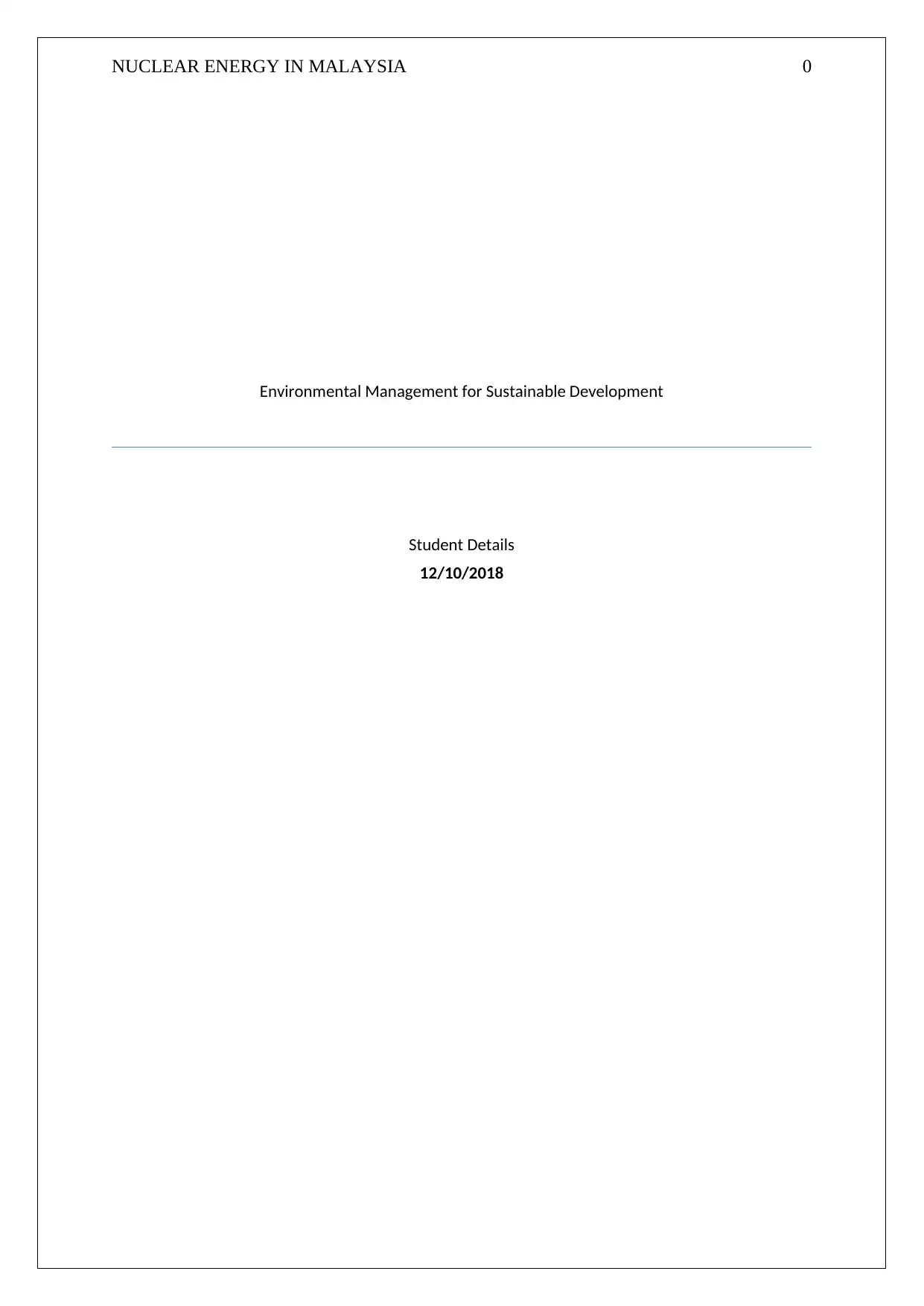
NUCLEAR ENERGY IN MALAYSIA 0
Environmental Management for Sustainable Development
Student Details
12/10/2018
Environmental Management for Sustainable Development
Student Details
12/10/2018
Paraphrase This Document
Need a fresh take? Get an instant paraphrase of this document with our AI Paraphraser
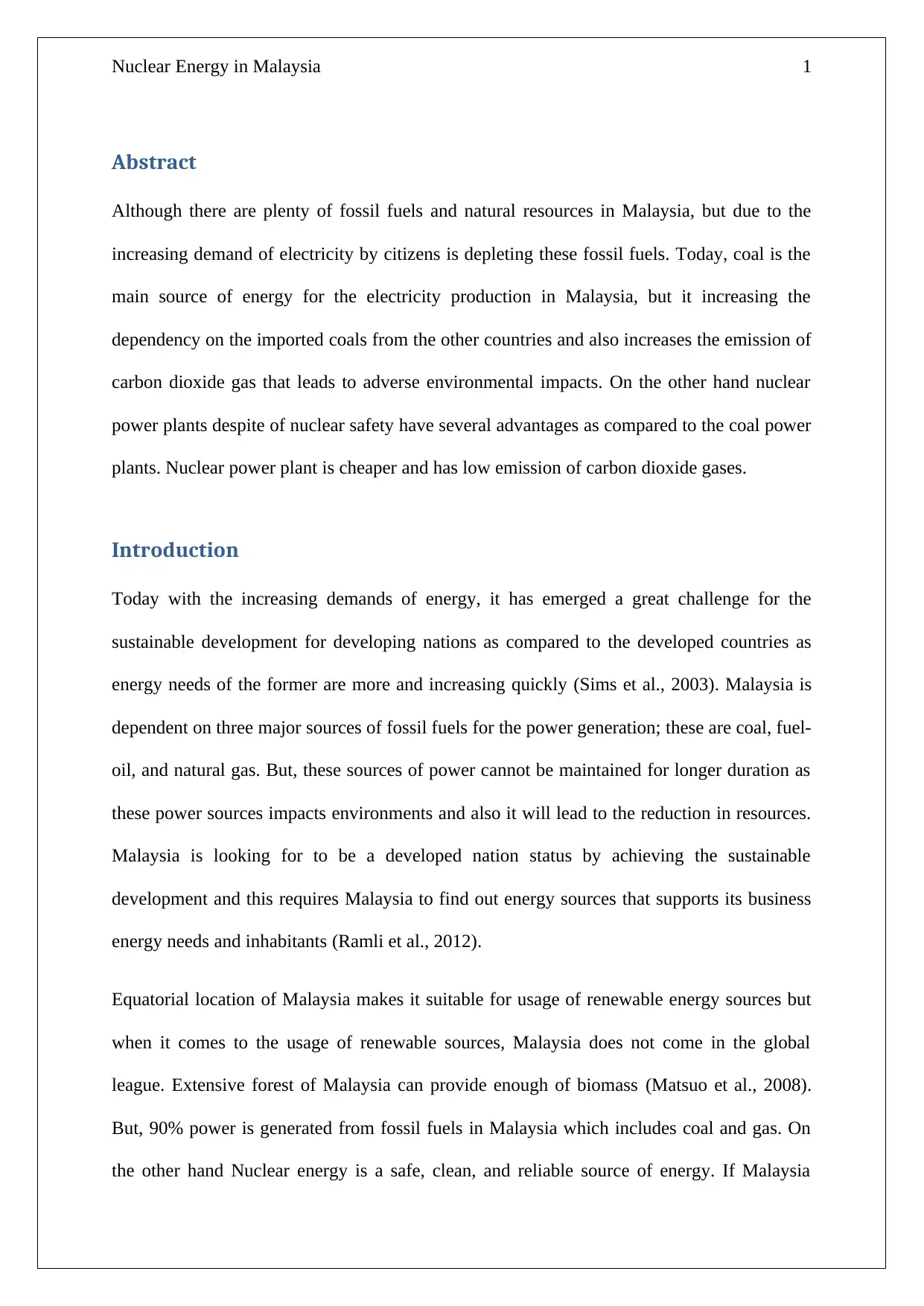
Nuclear Energy in Malaysia 1
Abstract
Although there are plenty of fossil fuels and natural resources in Malaysia, but due to the
increasing demand of electricity by citizens is depleting these fossil fuels. Today, coal is the
main source of energy for the electricity production in Malaysia, but it increasing the
dependency on the imported coals from the other countries and also increases the emission of
carbon dioxide gas that leads to adverse environmental impacts. On the other hand nuclear
power plants despite of nuclear safety have several advantages as compared to the coal power
plants. Nuclear power plant is cheaper and has low emission of carbon dioxide gases.
Introduction
Today with the increasing demands of energy, it has emerged a great challenge for the
sustainable development for developing nations as compared to the developed countries as
energy needs of the former are more and increasing quickly (Sims et al., 2003). Malaysia is
dependent on three major sources of fossil fuels for the power generation; these are coal, fuel-
oil, and natural gas. But, these sources of power cannot be maintained for longer duration as
these power sources impacts environments and also it will lead to the reduction in resources.
Malaysia is looking for to be a developed nation status by achieving the sustainable
development and this requires Malaysia to find out energy sources that supports its business
energy needs and inhabitants (Ramli et al., 2012).
Equatorial location of Malaysia makes it suitable for usage of renewable energy sources but
when it comes to the usage of renewable sources, Malaysia does not come in the global
league. Extensive forest of Malaysia can provide enough of biomass (Matsuo et al., 2008).
But, 90% power is generated from fossil fuels in Malaysia which includes coal and gas. On
the other hand Nuclear energy is a safe, clean, and reliable source of energy. If Malaysia
Abstract
Although there are plenty of fossil fuels and natural resources in Malaysia, but due to the
increasing demand of electricity by citizens is depleting these fossil fuels. Today, coal is the
main source of energy for the electricity production in Malaysia, but it increasing the
dependency on the imported coals from the other countries and also increases the emission of
carbon dioxide gas that leads to adverse environmental impacts. On the other hand nuclear
power plants despite of nuclear safety have several advantages as compared to the coal power
plants. Nuclear power plant is cheaper and has low emission of carbon dioxide gases.
Introduction
Today with the increasing demands of energy, it has emerged a great challenge for the
sustainable development for developing nations as compared to the developed countries as
energy needs of the former are more and increasing quickly (Sims et al., 2003). Malaysia is
dependent on three major sources of fossil fuels for the power generation; these are coal, fuel-
oil, and natural gas. But, these sources of power cannot be maintained for longer duration as
these power sources impacts environments and also it will lead to the reduction in resources.
Malaysia is looking for to be a developed nation status by achieving the sustainable
development and this requires Malaysia to find out energy sources that supports its business
energy needs and inhabitants (Ramli et al., 2012).
Equatorial location of Malaysia makes it suitable for usage of renewable energy sources but
when it comes to the usage of renewable sources, Malaysia does not come in the global
league. Extensive forest of Malaysia can provide enough of biomass (Matsuo et al., 2008).
But, 90% power is generated from fossil fuels in Malaysia which includes coal and gas. On
the other hand Nuclear energy is a safe, clean, and reliable source of energy. If Malaysia
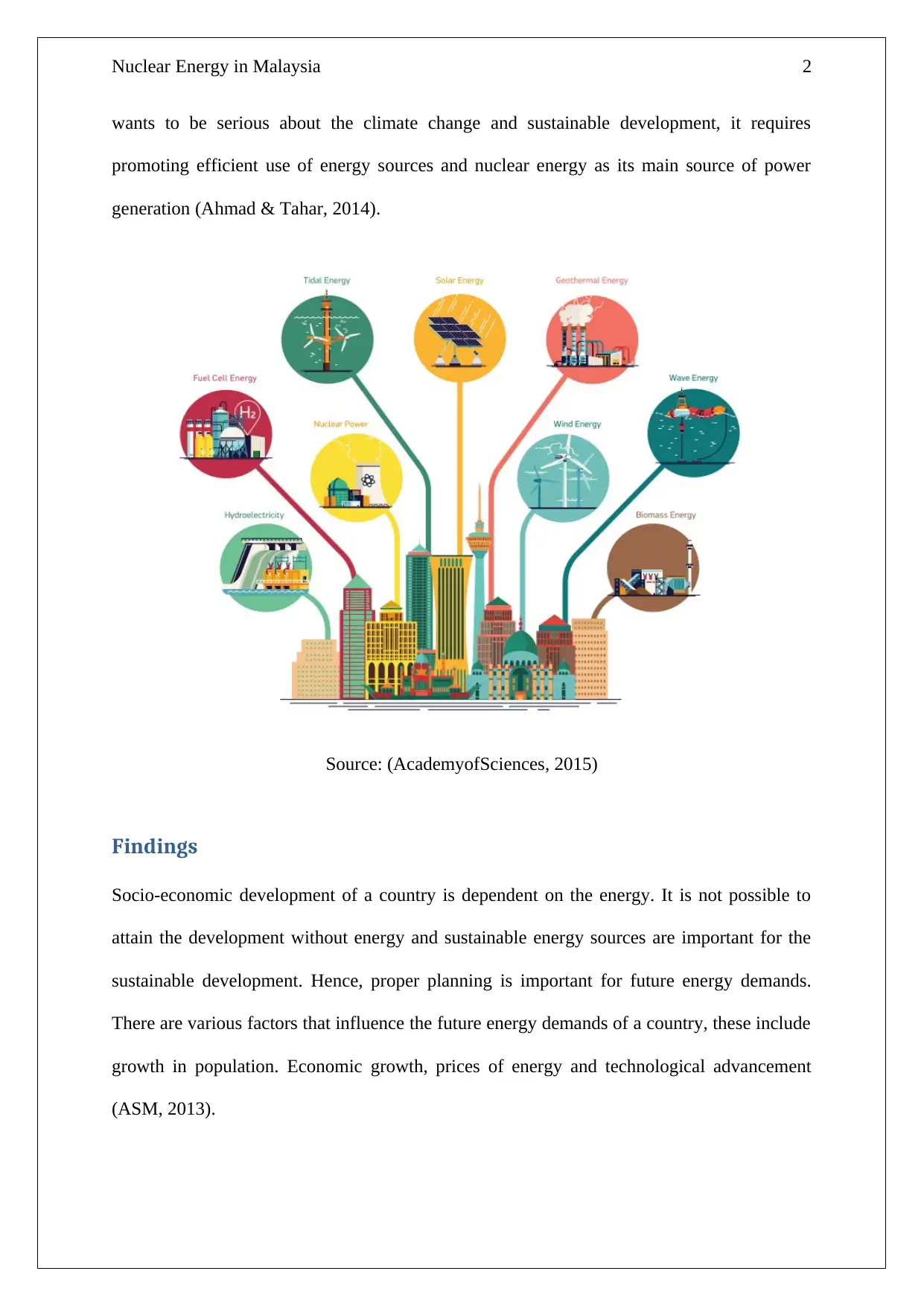
Nuclear Energy in Malaysia 2
wants to be serious about the climate change and sustainable development, it requires
promoting efficient use of energy sources and nuclear energy as its main source of power
generation (Ahmad & Tahar, 2014).
Source: (AcademyofSciences, 2015)
Findings
Socio-economic development of a country is dependent on the energy. It is not possible to
attain the development without energy and sustainable energy sources are important for the
sustainable development. Hence, proper planning is important for future energy demands.
There are various factors that influence the future energy demands of a country, these include
growth in population. Economic growth, prices of energy and technological advancement
(ASM, 2013).
wants to be serious about the climate change and sustainable development, it requires
promoting efficient use of energy sources and nuclear energy as its main source of power
generation (Ahmad & Tahar, 2014).
Source: (AcademyofSciences, 2015)
Findings
Socio-economic development of a country is dependent on the energy. It is not possible to
attain the development without energy and sustainable energy sources are important for the
sustainable development. Hence, proper planning is important for future energy demands.
There are various factors that influence the future energy demands of a country, these include
growth in population. Economic growth, prices of energy and technological advancement
(ASM, 2013).
⊘ This is a preview!⊘
Do you want full access?
Subscribe today to unlock all pages.

Trusted by 1+ million students worldwide
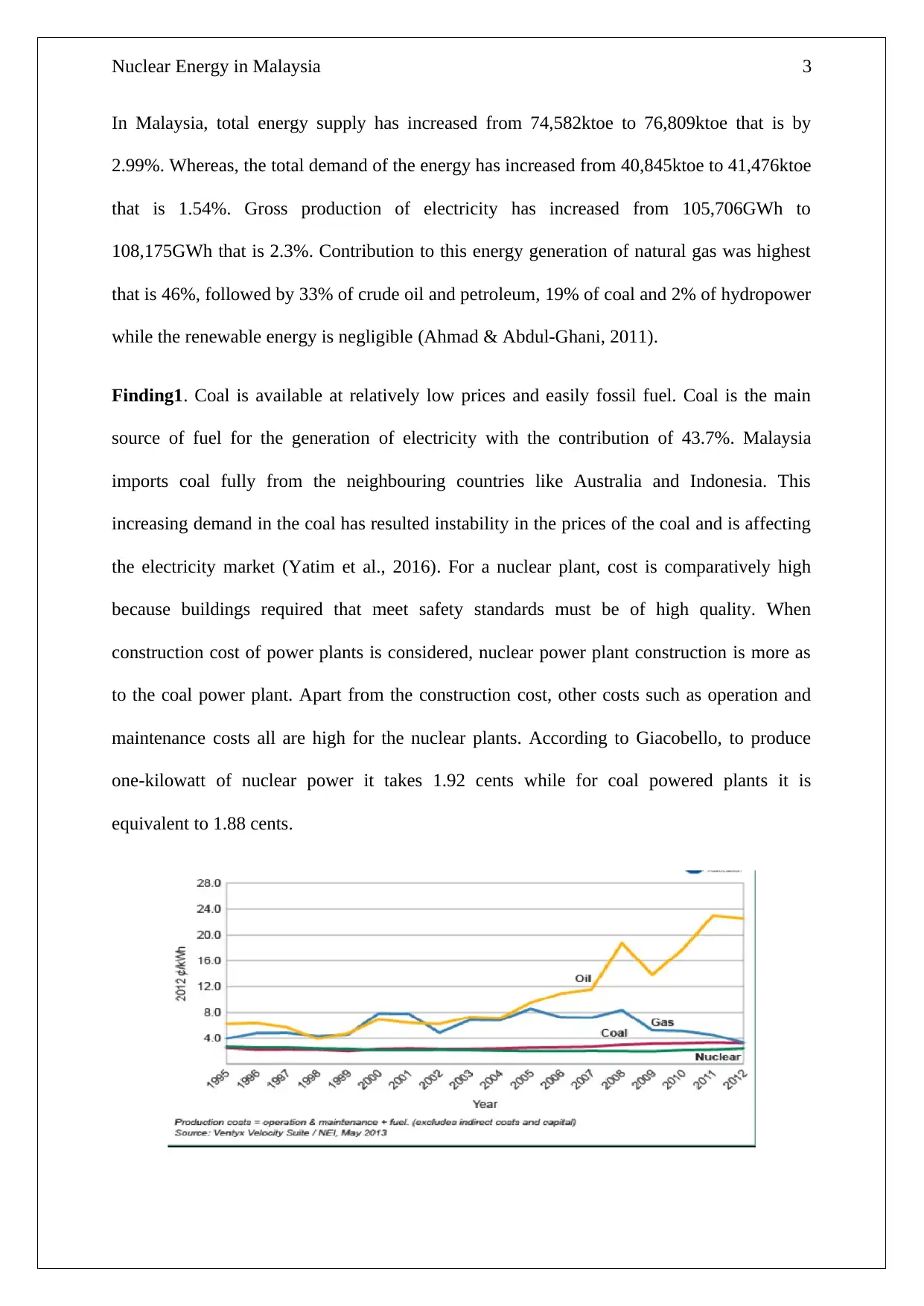
Nuclear Energy in Malaysia 3
In Malaysia, total energy supply has increased from 74,582ktoe to 76,809ktoe that is by
2.99%. Whereas, the total demand of the energy has increased from 40,845ktoe to 41,476ktoe
that is 1.54%. Gross production of electricity has increased from 105,706GWh to
108,175GWh that is 2.3%. Contribution to this energy generation of natural gas was highest
that is 46%, followed by 33% of crude oil and petroleum, 19% of coal and 2% of hydropower
while the renewable energy is negligible (Ahmad & Abdul-Ghani, 2011).
Finding1. Coal is available at relatively low prices and easily fossil fuel. Coal is the main
source of fuel for the generation of electricity with the contribution of 43.7%. Malaysia
imports coal fully from the neighbouring countries like Australia and Indonesia. This
increasing demand in the coal has resulted instability in the prices of the coal and is affecting
the electricity market (Yatim et al., 2016). For a nuclear plant, cost is comparatively high
because buildings required that meet safety standards must be of high quality. When
construction cost of power plants is considered, nuclear power plant construction is more as
to the coal power plant. Apart from the construction cost, other costs such as operation and
maintenance costs all are high for the nuclear plants. According to Giacobello, to produce
one-kilowatt of nuclear power it takes 1.92 cents while for coal powered plants it is
equivalent to 1.88 cents.
In Malaysia, total energy supply has increased from 74,582ktoe to 76,809ktoe that is by
2.99%. Whereas, the total demand of the energy has increased from 40,845ktoe to 41,476ktoe
that is 1.54%. Gross production of electricity has increased from 105,706GWh to
108,175GWh that is 2.3%. Contribution to this energy generation of natural gas was highest
that is 46%, followed by 33% of crude oil and petroleum, 19% of coal and 2% of hydropower
while the renewable energy is negligible (Ahmad & Abdul-Ghani, 2011).
Finding1. Coal is available at relatively low prices and easily fossil fuel. Coal is the main
source of fuel for the generation of electricity with the contribution of 43.7%. Malaysia
imports coal fully from the neighbouring countries like Australia and Indonesia. This
increasing demand in the coal has resulted instability in the prices of the coal and is affecting
the electricity market (Yatim et al., 2016). For a nuclear plant, cost is comparatively high
because buildings required that meet safety standards must be of high quality. When
construction cost of power plants is considered, nuclear power plant construction is more as
to the coal power plant. Apart from the construction cost, other costs such as operation and
maintenance costs all are high for the nuclear plants. According to Giacobello, to produce
one-kilowatt of nuclear power it takes 1.92 cents while for coal powered plants it is
equivalent to 1.88 cents.
Paraphrase This Document
Need a fresh take? Get an instant paraphrase of this document with our AI Paraphraser
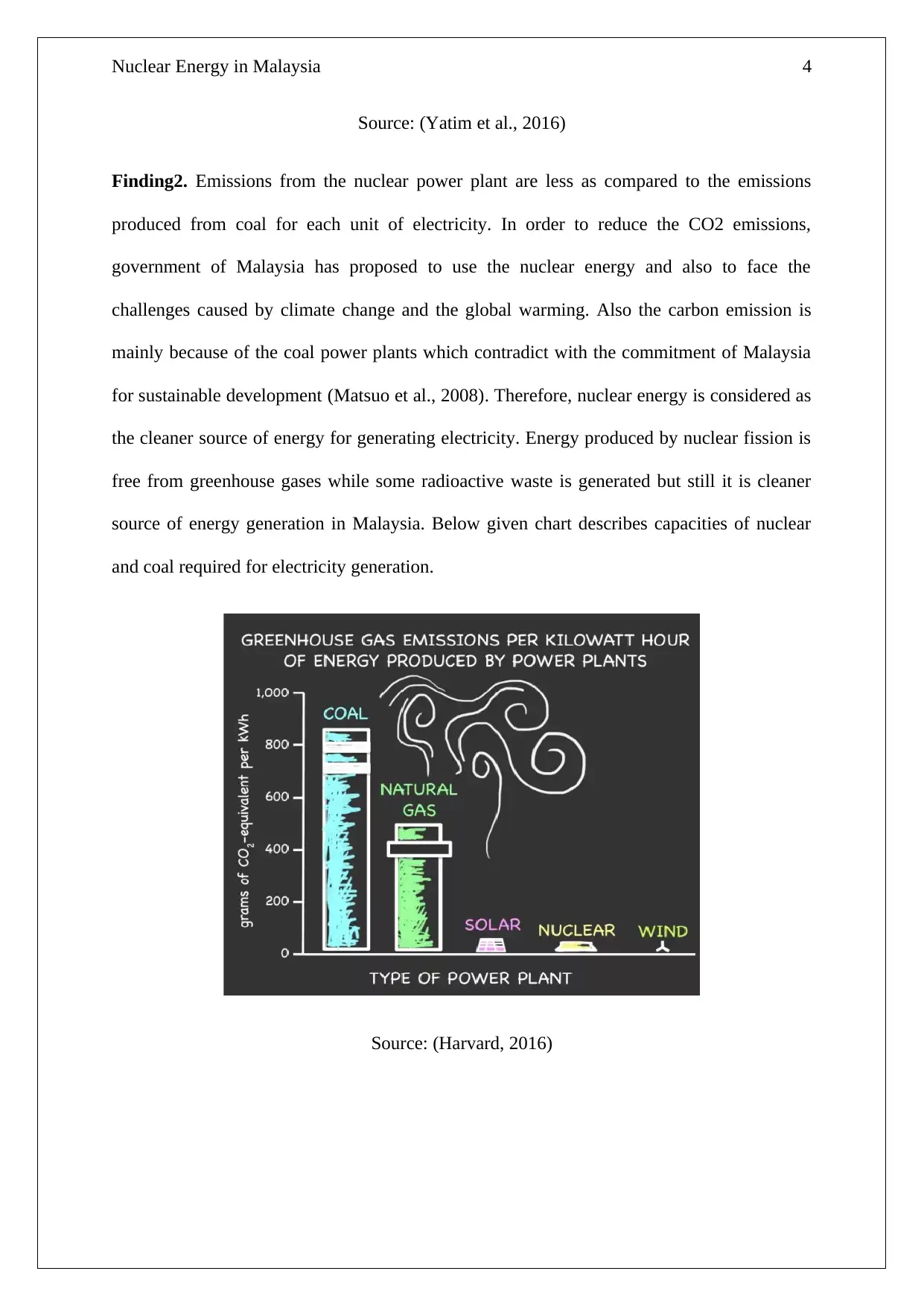
Nuclear Energy in Malaysia 4
Source: (Yatim et al., 2016)
Finding2. Emissions from the nuclear power plant are less as compared to the emissions
produced from coal for each unit of electricity. In order to reduce the CO2 emissions,
government of Malaysia has proposed to use the nuclear energy and also to face the
challenges caused by climate change and the global warming. Also the carbon emission is
mainly because of the coal power plants which contradict with the commitment of Malaysia
for sustainable development (Matsuo et al., 2008). Therefore, nuclear energy is considered as
the cleaner source of energy for generating electricity. Energy produced by nuclear fission is
free from greenhouse gases while some radioactive waste is generated but still it is cleaner
source of energy generation in Malaysia. Below given chart describes capacities of nuclear
and coal required for electricity generation.
Source: (Harvard, 2016)
Source: (Yatim et al., 2016)
Finding2. Emissions from the nuclear power plant are less as compared to the emissions
produced from coal for each unit of electricity. In order to reduce the CO2 emissions,
government of Malaysia has proposed to use the nuclear energy and also to face the
challenges caused by climate change and the global warming. Also the carbon emission is
mainly because of the coal power plants which contradict with the commitment of Malaysia
for sustainable development (Matsuo et al., 2008). Therefore, nuclear energy is considered as
the cleaner source of energy for generating electricity. Energy produced by nuclear fission is
free from greenhouse gases while some radioactive waste is generated but still it is cleaner
source of energy generation in Malaysia. Below given chart describes capacities of nuclear
and coal required for electricity generation.
Source: (Harvard, 2016)
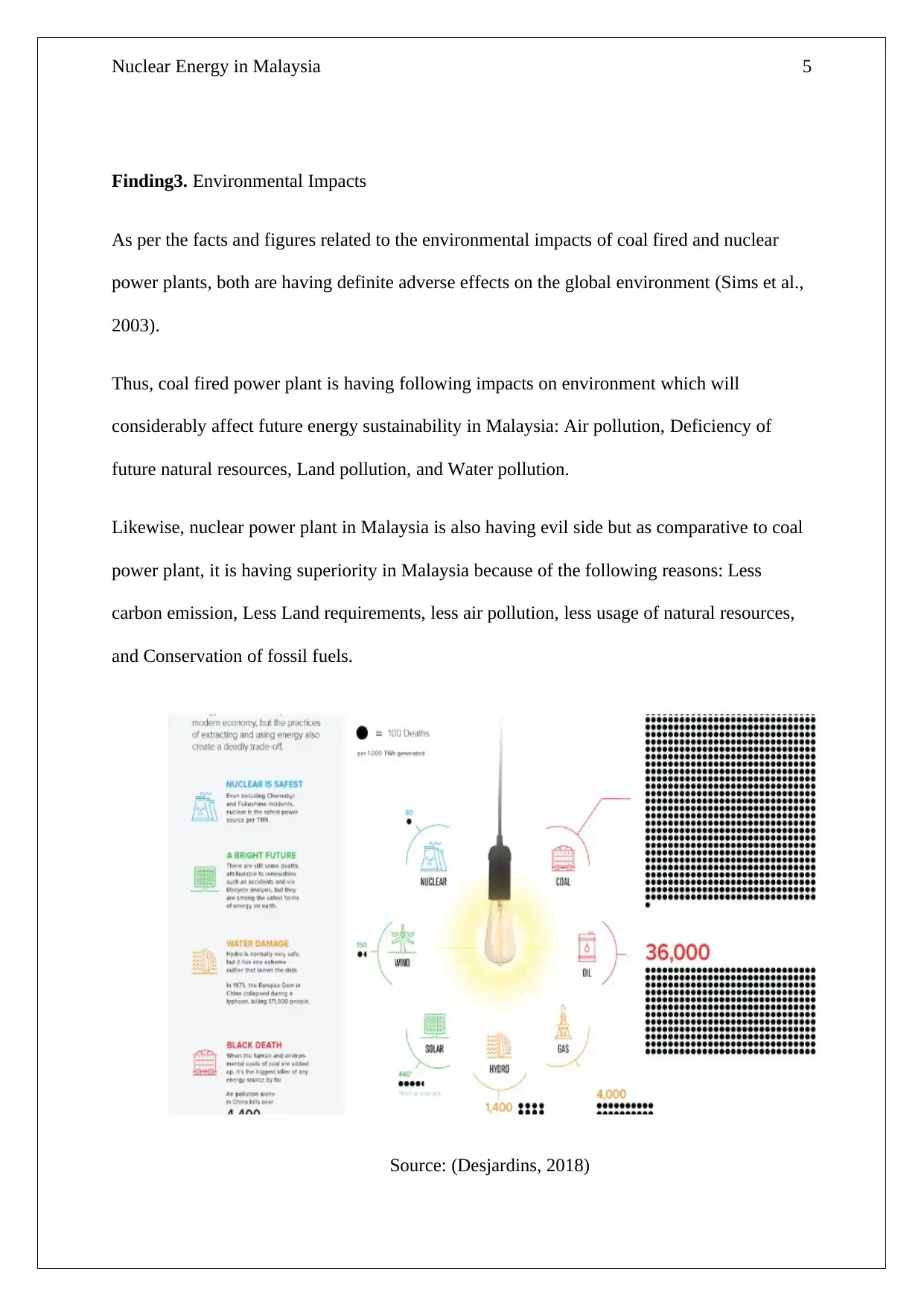
Nuclear Energy in Malaysia 5
Finding3. Environmental Impacts
As per the facts and figures related to the environmental impacts of coal fired and nuclear
power plants, both are having definite adverse effects on the global environment (Sims et al.,
2003).
Thus, coal fired power plant is having following impacts on environment which will
considerably affect future energy sustainability in Malaysia: Air pollution, Deficiency of
future natural resources, Land pollution, and Water pollution.
Likewise, nuclear power plant in Malaysia is also having evil side but as comparative to coal
power plant, it is having superiority in Malaysia because of the following reasons: Less
carbon emission, Less Land requirements, less air pollution, less usage of natural resources,
and Conservation of fossil fuels.
Source: (Desjardins, 2018)
Finding3. Environmental Impacts
As per the facts and figures related to the environmental impacts of coal fired and nuclear
power plants, both are having definite adverse effects on the global environment (Sims et al.,
2003).
Thus, coal fired power plant is having following impacts on environment which will
considerably affect future energy sustainability in Malaysia: Air pollution, Deficiency of
future natural resources, Land pollution, and Water pollution.
Likewise, nuclear power plant in Malaysia is also having evil side but as comparative to coal
power plant, it is having superiority in Malaysia because of the following reasons: Less
carbon emission, Less Land requirements, less air pollution, less usage of natural resources,
and Conservation of fossil fuels.
Source: (Desjardins, 2018)
⊘ This is a preview!⊘
Do you want full access?
Subscribe today to unlock all pages.

Trusted by 1+ million students worldwide
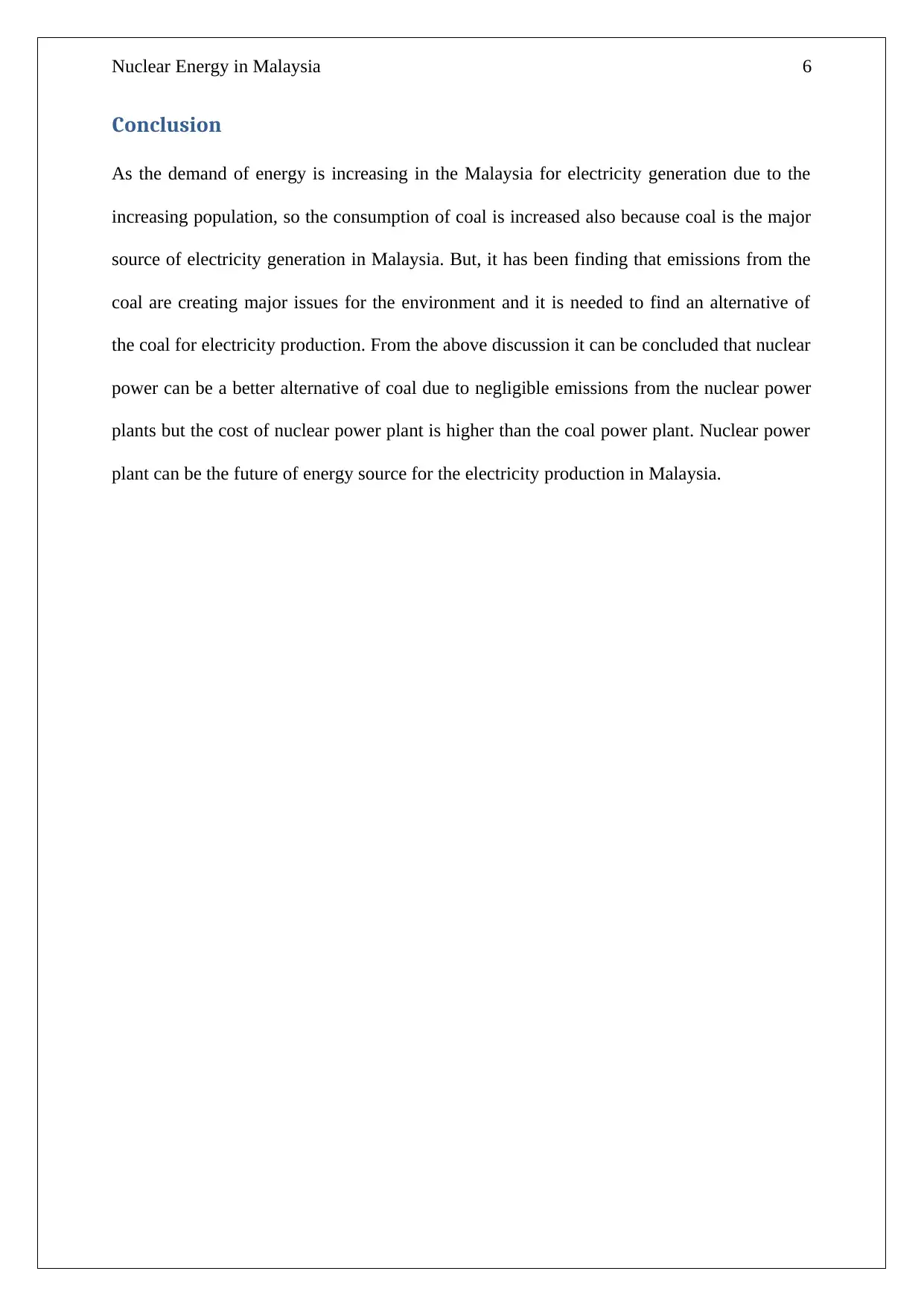
Nuclear Energy in Malaysia 6
Conclusion
As the demand of energy is increasing in the Malaysia for electricity generation due to the
increasing population, so the consumption of coal is increased also because coal is the major
source of electricity generation in Malaysia. But, it has been finding that emissions from the
coal are creating major issues for the environment and it is needed to find an alternative of
the coal for electricity production. From the above discussion it can be concluded that nuclear
power can be a better alternative of coal due to negligible emissions from the nuclear power
plants but the cost of nuclear power plant is higher than the coal power plant. Nuclear power
plant can be the future of energy source for the electricity production in Malaysia.
Conclusion
As the demand of energy is increasing in the Malaysia for electricity generation due to the
increasing population, so the consumption of coal is increased also because coal is the major
source of electricity generation in Malaysia. But, it has been finding that emissions from the
coal are creating major issues for the environment and it is needed to find an alternative of
the coal for electricity production. From the above discussion it can be concluded that nuclear
power can be a better alternative of coal due to negligible emissions from the nuclear power
plants but the cost of nuclear power plant is higher than the coal power plant. Nuclear power
plant can be the future of energy source for the electricity production in Malaysia.
Paraphrase This Document
Need a fresh take? Get an instant paraphrase of this document with our AI Paraphraser
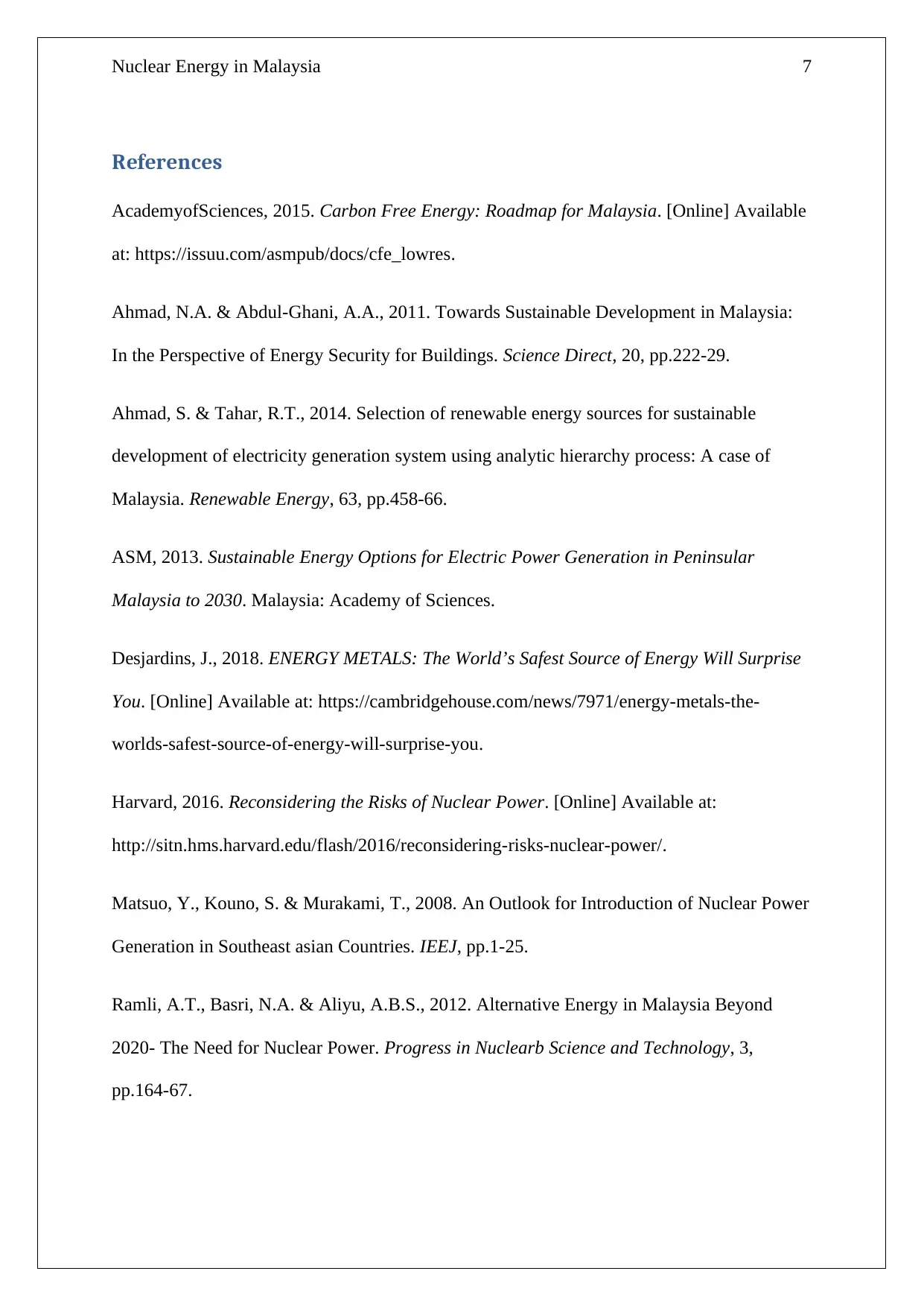
Nuclear Energy in Malaysia 7
References
AcademyofSciences, 2015. Carbon Free Energy: Roadmap for Malaysia. [Online] Available
at: https://issuu.com/asmpub/docs/cfe_lowres.
Ahmad, N.A. & Abdul-Ghani, A.A., 2011. Towards Sustainable Development in Malaysia:
In the Perspective of Energy Security for Buildings. Science Direct, 20, pp.222-29.
Ahmad, S. & Tahar, R.T., 2014. Selection of renewable energy sources for sustainable
development of electricity generation system using analytic hierarchy process: A case of
Malaysia. Renewable Energy, 63, pp.458-66.
ASM, 2013. Sustainable Energy Options for Electric Power Generation in Peninsular
Malaysia to 2030. Malaysia: Academy of Sciences.
Desjardins, J., 2018. ENERGY METALS: The World’s Safest Source of Energy Will Surprise
You. [Online] Available at: https://cambridgehouse.com/news/7971/energy-metals-the-
worlds-safest-source-of-energy-will-surprise-you.
Harvard, 2016. Reconsidering the Risks of Nuclear Power. [Online] Available at:
http://sitn.hms.harvard.edu/flash/2016/reconsidering-risks-nuclear-power/.
Matsuo, Y., Kouno, S. & Murakami, T., 2008. An Outlook for Introduction of Nuclear Power
Generation in Southeast asian Countries. IEEJ, pp.1-25.
Ramli, A.T., Basri, N.A. & Aliyu, A.B.S., 2012. Alternative Energy in Malaysia Beyond
2020- The Need for Nuclear Power. Progress in Nuclearb Science and Technology, 3,
pp.164-67.
References
AcademyofSciences, 2015. Carbon Free Energy: Roadmap for Malaysia. [Online] Available
at: https://issuu.com/asmpub/docs/cfe_lowres.
Ahmad, N.A. & Abdul-Ghani, A.A., 2011. Towards Sustainable Development in Malaysia:
In the Perspective of Energy Security for Buildings. Science Direct, 20, pp.222-29.
Ahmad, S. & Tahar, R.T., 2014. Selection of renewable energy sources for sustainable
development of electricity generation system using analytic hierarchy process: A case of
Malaysia. Renewable Energy, 63, pp.458-66.
ASM, 2013. Sustainable Energy Options for Electric Power Generation in Peninsular
Malaysia to 2030. Malaysia: Academy of Sciences.
Desjardins, J., 2018. ENERGY METALS: The World’s Safest Source of Energy Will Surprise
You. [Online] Available at: https://cambridgehouse.com/news/7971/energy-metals-the-
worlds-safest-source-of-energy-will-surprise-you.
Harvard, 2016. Reconsidering the Risks of Nuclear Power. [Online] Available at:
http://sitn.hms.harvard.edu/flash/2016/reconsidering-risks-nuclear-power/.
Matsuo, Y., Kouno, S. & Murakami, T., 2008. An Outlook for Introduction of Nuclear Power
Generation in Southeast asian Countries. IEEJ, pp.1-25.
Ramli, A.T., Basri, N.A. & Aliyu, A.B.S., 2012. Alternative Energy in Malaysia Beyond
2020- The Need for Nuclear Power. Progress in Nuclearb Science and Technology, 3,
pp.164-67.
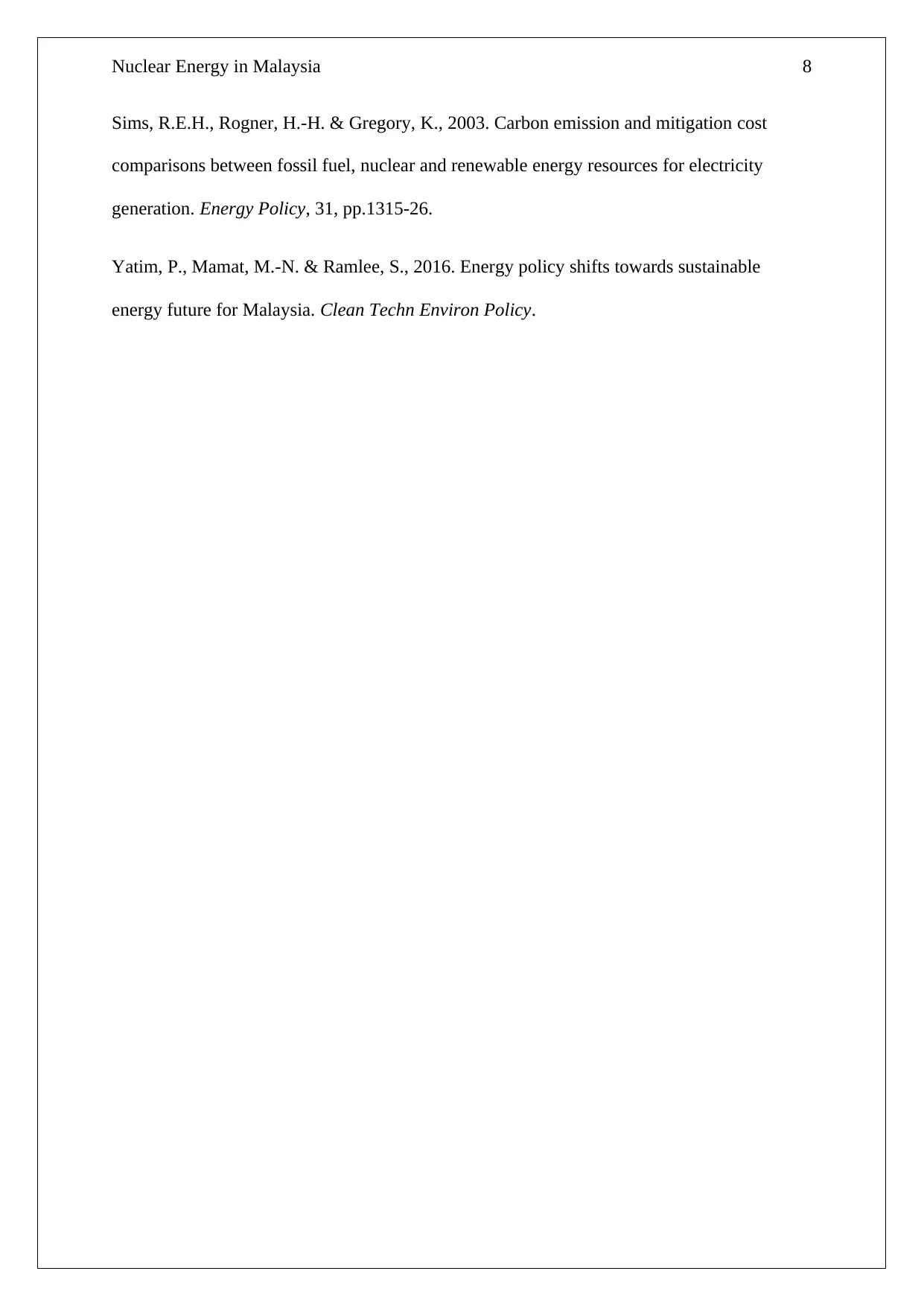
Nuclear Energy in Malaysia 8
Sims, R.E.H., Rogner, H.-H. & Gregory, K., 2003. Carbon emission and mitigation cost
comparisons between fossil fuel, nuclear and renewable energy resources for electricity
generation. Energy Policy, 31, pp.1315-26.
Yatim, P., Mamat, M.-N. & Ramlee, S., 2016. Energy policy shifts towards sustainable
energy future for Malaysia. Clean Techn Environ Policy.
Sims, R.E.H., Rogner, H.-H. & Gregory, K., 2003. Carbon emission and mitigation cost
comparisons between fossil fuel, nuclear and renewable energy resources for electricity
generation. Energy Policy, 31, pp.1315-26.
Yatim, P., Mamat, M.-N. & Ramlee, S., 2016. Energy policy shifts towards sustainable
energy future for Malaysia. Clean Techn Environ Policy.
⊘ This is a preview!⊘
Do you want full access?
Subscribe today to unlock all pages.

Trusted by 1+ million students worldwide
1 out of 9
Related Documents
Your All-in-One AI-Powered Toolkit for Academic Success.
+13062052269
info@desklib.com
Available 24*7 on WhatsApp / Email
![[object Object]](/_next/static/media/star-bottom.7253800d.svg)
Unlock your academic potential
Copyright © 2020–2025 A2Z Services. All Rights Reserved. Developed and managed by ZUCOL.





